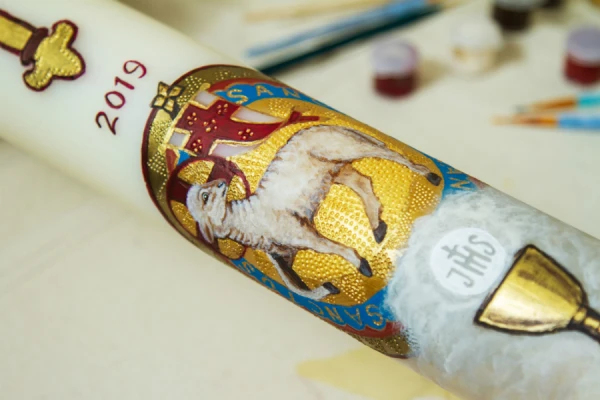
Omaha, Neb., Apr 17, 2019 / 03:01 am (CNA).- Michelangelo, Rembrandt, and Caravaggio have blessed mankind with stunning works of art. They gave themselves ample space to create: For Michelangelo, it was the ceiling of the Sistine Chapel. For Rembrandt and Caravaggio, often it was large canvases.
Omaha artist Robert Faulhaber doesn’t have the luxury of space when he paints. The medium on which he works is the slender surface of a Paschal candle.
The ritual of the Paschal candle
This candle is an integral part of services during the Easter season, and beyond. It is lit each day during Mass throughout the Easter season until Ascension Thursday, and then again for baptisms and funerals.
Made of beeswax, it represents Christ, the sinless Light of the World. The wick signifies his humanity, and the flame his divinity.
Five grains of incense embedded in the candle in the form of a cross recall the perfumed spices that prepared Christ’s body for the tomb, and his five sacred wounds.
During the Easter Vigil, the priest or deacon carries the candle in procession into the dark church. A new fire symbolizing our eternal life in Christ is kindled, which in turn lights the candle.
As he chants a prayer, the priest blesses the candle. He carves in it a cross, the first letters and last of the Greek alphabet (Alpha and Omega, “the beginning and the end”) and the current year; then he inserts the five grains of incense.
The size of a Paschal candle can range from 3 to 4 inches in diameter and 48 to 61 inches high. The actual space Faulhaber has to paint is a mere 7 by 24 inches.
Most parishes get their candles from a church supply store, and the decorative features on them look mostly the same.
However, each of Faulhaber’s candles is a one-of-a-kind creation.
“I begin each new project by praying to the Holy Spirit,” Faulhauber said. “I want every candle to glorify God.”
Although some of Faulhaber’s candles may have the same central design, no two share the same borders, colors, and details. “There are no other candles like mine in the entire world.”
Photo credit: Brandonmckenna.com
A faith-based childhood
Faulhaber, 52, was born in Davenport, Iowa, and moved to Rock Island, Illinois, when he was 10. His youth was shaped by a love of drawing, sketching, and painting.
“I started drawing when I was three years old,” he said.
Faulhaber grew up in a household where the Catholic faith was expressed and witnessed. He often attended daily Mass with his mother, and his parents frequently talked about religious vocations. Two of his uncles were priests, and an aunt was a nun.
He failed the first grade because of a learning disability, making him the target of his classmates’ jokes.
Every day his mother sent him with a homemade lunch and the instructions to “take Jesus to school with you.”
He says his mom’s advice changed his life. “It no longer mattered what my classmates might say to me. I knew Jesus loved me.”
Developing valuable relationships
In Rock Island, many of Faulhaber’s friends were Native Americans. It was through those friendships that he developed a passion for their culture and music.
Soon he was a regular at powwows, the Native American cultural event that features group singing and dancing. Before long, he was participating in the ceremonies.
When he was 16, he used his artistic talent to make his first rawhide drum. He still makes drums today, in addition to the outfits and beadwork he wears when performing in powwows throughout the U.S. and Canada.
After graduating from Rock Island High School, Faulhaber moved to Des Moines and continued to attend daily Mass with his mother. He also accompanied her to Thursday night prayer meetings at the Basilica of St. John in Des Moines.
It was there he met Monsignor Frank Chiodo, who introduced him to monastic life. Msgr. Chiodo was living at the basilica at the time.
At 33, Faulhaber had no life plan. After his move to Des Moines, he held various jobs with a Midwest grocery store chain. It was good work, but he wanted more out of life, and he knew more awaited him.
Falulhaber decided to give up his few possessions and walk away from the only life he knew to join the Society of St. John, a religious order founded by Msgr. Chiodo.
While part of that community, he painted his first Paschal candle – a depiction of Christ sitting on a throne holding a book titled “I AM.”
“I’ll always remember my first candle,” Faulhaber said. “I had to pray hard for God’s help.”
He found himself in uncharted waters, so he put to good use his familiarity and experience with icon writing when painting on beeswax the first time.
When he finished, Faulhaber remembers stepping back from that first candle and whispering to himself, “What did I do?”
People stood in line inside the basilica to admire the candle. “It was the first time they had ever seen candle art. It was my first time, too.”
Studying iconography
Faulhaber, or Brother Bob as he was known then, transferred in 2002 to Mount Michael Abbey in Elkhorn, Nebraska. He painted several Paschal candles for the abbey.
The abbey supported Faulhaber’s interest in other art forms and sent him to the prestigious Prosopon School of Iconology in Wisconsin.
There he learned the Russian method of icon writing, which uses a paste made of raw materials, egg yolk, vinegar, and wine.
Two of his icons are at St. James Parish in Omaha. Other pieces are at St. John’s Parish in Duluth, Minnesota, and Saint Meinrad Seminary and School of Theology in St. Meinrad, Indiana.
Faulhaber eventually ended up departing religious life in 2010 and was dispensed from his vows.
“I owe a lot to religious life,” he said. “The priests and brothers know how to cultivate and hone a person’s skills. They are able to identify and develop your talents. In my case, it was art.”
‘A prayerful, leisurely experience’
It takes Faulhaber 40 to 50 hours to paint a Paschal candle. Before he begins, he photographs the inside of the church where the candle will be displayed, researches the church’s patron saint, and studies the history of the church.
When the research is finished, he carves a design on the beeswax, and fills it with acrylic paint. He describes the process as a “prayerful and leisurely experience … Sometimes I listen to music while I’m painting.”
The Easter Vigil liturgy itself is an emotional experience for Faulhaber. He watches from a pew as the candle is carried in procession into the dark church, then prominently displayed in the candle stand in the sanctuary.
It is when the priest or deacon intones one of the most evocative and poetic hymns of praise in all liturgy, the Exsultet – also known as the Easter Proclamation – that his eyes fill with tears and his heart overflows with joy.
“It’s powerful knowing my hand is involved in some small way in the Church’s most meaningful act of worship,” Faulhaber said. “At the same time, I want to hide and just do my art. It’s about Jesus.”
A multi-dimensional artist
Faulhaber and his wife, Jeanna, are members of St. Bernard parish in Omaha. He has painted St. Bernard’s Paschal candles since 2014. His candles are also used in Omaha churches St. Stephen the Martyr and St. Thomas More.
It was Faulhaber’s idea to paint a candle for St. Bernard. He recognized how the church’s regal interior colors, dark wood pews, and floor tile design worked together to direct a person’s mind and heart toward the sanctuary.
He told Father Walter Nolte, St. Bernard’s pastor at the time, that like an icon, a Paschal candle should point to something beyond itself.
“Robert spent hours in the church, praying and sketching,” Father Nolte said.
Faulhaber presented him with several design concepts.
“He wanted me to choose from his ideas,” the priest said. “I refused. I told him I had complete trust in him, and I would graciously receive what he brought to us from his prayer.”
The finished design skillfully uses the small church’s Spanish mission style colors and spiral columns to depict Christ the King.
When he’s not working in the maintenance department at St. Stephen the Martyr Church, Faulhaber paints.
He considers himself a multi-dimensional artist; besides paint, his tools include chalk, pencil and airbrushes. He’s also a wood carver.
While Michelangelo, Rembrandt, and Caravaggio’s biggest art pieces have endured over time, Faulhaber is one of only a few artists who knowingly sets out to create something that will eventually melt from the heat of a flame.
Yet because of the role they have in the sacramental life of the Church, his creations will, in a sense, share in eternity.
If you value the news and views Catholic World Report provides, please consider donating to support our efforts. Your contribution will help us continue to make CWR available to all readers worldwide for free, without a subscription. Thank you for your generosity!
Click here for more information on donating to CWR. Click here to sign up for our newsletter.








Leave a Reply